To view this content, you must be a member of the Rose City Review Patreon
Already a qualifying Patreon member? Refresh to access this content.

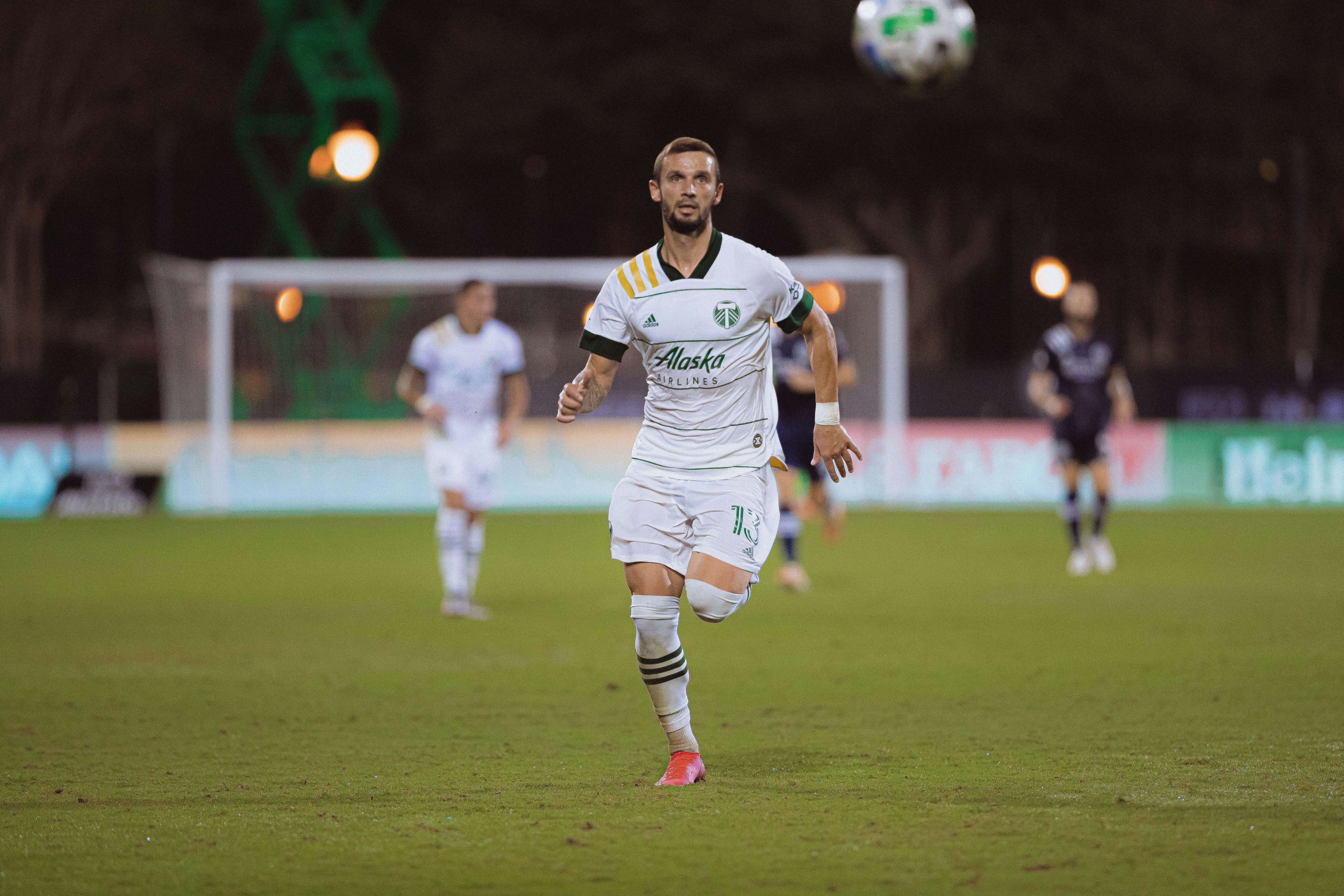
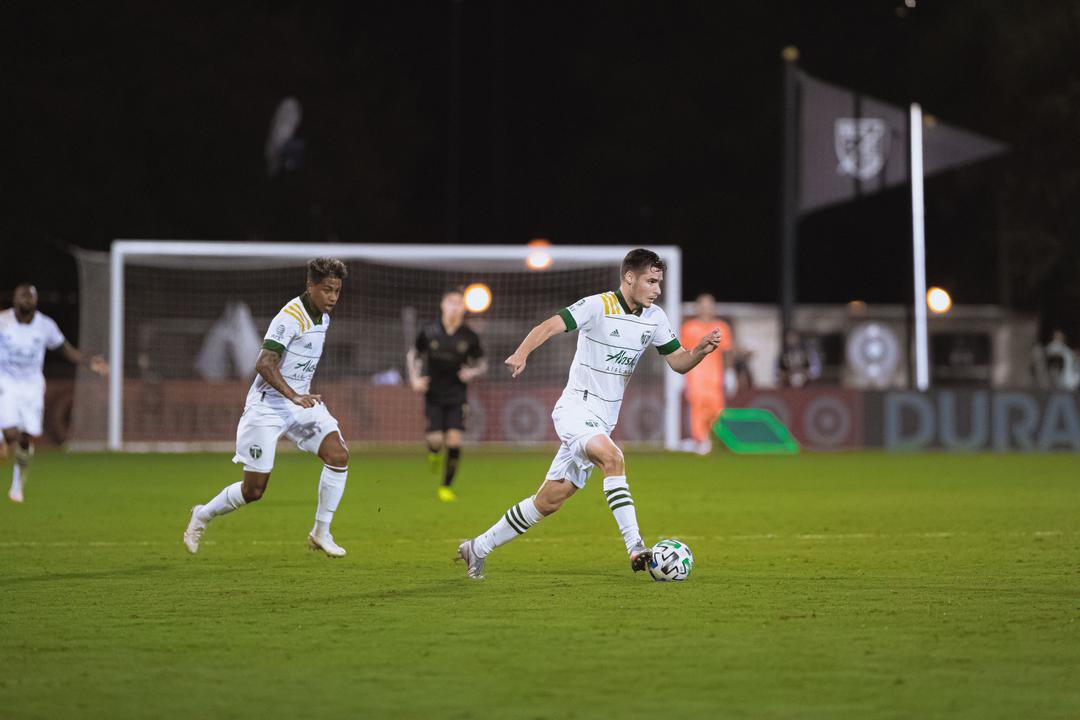
Match after match, the Portland Timbers continue to impress.
Two games in, and it seems as if there’s something new and more creative to take away from each game—something that we did not see back in March.
Against the Los Angeles Galaxy, we saw an increased sense of confidence throughout the team that manifested itself through the team’s combination play and intricate movement. In its game against Houston, we saw a team both creating and exploiting space all around the field, playing long balls with a purpose to unlock the Dynamo defense while shutting down one of Major League Soccer’s most potent attacks.
Portland did it again on Thursday night, coming in with a disciplined and compact defensive shape that managed to contain what is usually a LAFC buzzsaw to win Group F.
I don’t have much to say to open this column other than just to mention how impressive this Portland team has been over three games. The shape that the Timbers played last night required a lot of discipline (which I will go into later). I mentioned on Twitter than containing LAFC for 90 minutes is a Herculean effort––both the Dynamo and Galaxy learned that over the past week––and Portland looked defensively solid for more than 75 percent of the game. I guess what I am saying is that the Timbers look primed to make a run in this tournament and that my outlook on the team is a lot brighter than what it was when I left Providence Park back in March.
And … I guess I should mention that I had to put my bonfire-building supplies away late into the match. It’s time for the Timbers to get revenge for what was an embarrassing defeat a season ago.
The Timbers got out to a dream start against LAFC, striking first in the seventh minute.
Taking advantage of LAFC’s aggression, Portland found success in testing the opposing backline early and often. Thanks to ESPN’s aerial cam, it’s easy to see what went into Niezgoda’s opening goal, the Pole’s first as a Timber.
During this transitional moment, Portland creates a mini-overload on the right side of the field. During this, Niezgoda is sitting between the right center back and right back, waiting to pounce. The overload pulls Tristan Blackmon towards the sideline while Latif Blessing, the right back, is caught cheating a little too far up the field. This leaves Niezgoda with yards of space to run into, and he makes the finish look easy.
Conceding first is not a new trend for Bob Bradley’s men: They did it against both the Houston Dynamo and LA Galaxy. This may be looked back upon as an easy finish, but the goal proved vital for the Timbers, allowing them to weather 15 minutes of LAFC brilliance and come away with a point at the end of the game.
Yes, Bradley Wright-Phillips is not the same lethal player that carried the New York Red Bulls on his shoulders for what seems like a decade, but he is still one of the most dangerous strikers in MLS—and he proved it yet again on Thursday night.
This goal comes down to movement. Wright-Phillips sees the right side of defense pushed high and immediately makes a looping run to find that space while losing his defender, Bill Tuiloma, in the process.
Thanks to the space that his movement created, when Wright-Phillips receives the ball, he has a few touches to settle it before firing it past Clark. This is a clinical, outside-the-box finish from the Englishman, proving that age is just a number.
In his post-game media availability, head coach, Giovanni Savarese, mentioned the tired legs that his team was playing with near the end of the first half. That can easily be seen in the second goal the Timbers gave up in the course of four minutes.
Honestly, there is not too much to this goal. It’s just poor marking at the back post by Bill Tuiloma as Kaye gets by him with a quick spin move. Kudos to the Canadian for the good finish, because there’s nothing that Clark could really do there.
In a tournament with so many young players breaking out for their respective teams, Jeremy Ebobisse’s star may shine among the brightest.
For the third-consecutive game, Ebobisse found the back of the net for Portland, this time rising up and sending a towering header past Sisniega.
This is just pure grit from some of the Timbers tallest players. In a way, Tuiloma makes up for his role in the two LAFC goals as he finds the energy to rise up and win this ball in a crowded box. After a missed half-chance minutes earlier, Ebobisse makes no mistake this time as he powered the ball to the bottom right corner.
Ebobisse is making a name for himself so far this tournament. You have to think that US Men’s National Team coach, Gregg Berhalter, is watching every game in the bubble with a close eye and Ebobisse is commanding his attention.
One of my biggest takeaways from this match is the defense shape that the Timbers played in. It was a narrow 4-4-2, both horizontally and vertically, that allowed space out wide, but prevented any penetration from a LAFC lineup that knows how to exploit even a sliver of space. Playing with such a compact shape for 90 minutes against one of the league’s best sides requires insane amounts of focus and discipline. Give or take a few moments, the Timbers looked relatively drilled in this setup.
The 4-4-2 did its job for a majority of the game. As seen above, LAFC was content to pass it backwards and around the block. To exploit this system, the ball needs to be played quickly between the lines with a purpose. Because LAFC played more of a probing style early on in the game, players were able to step up and win balls in both defense and midfield. According to Opta, the Timbers made 40 CLEARANCES(!!!) over the course of the game compared to LAFC’s eight.
Below, I’m going to insert a couple of examples of what the Timbers want to do. It’s a lot of last-ditch tackling that happened time and time again throughout the game.
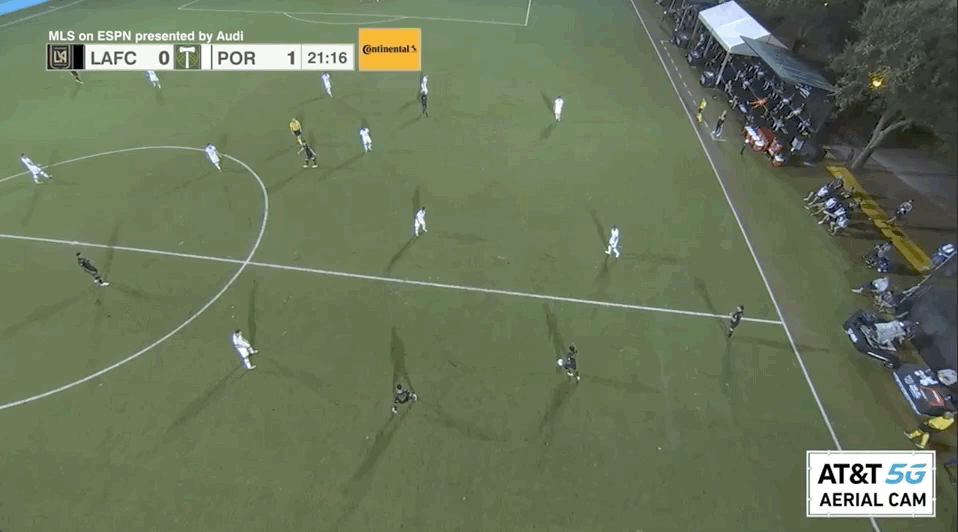
In this clip, the midfield does a good job of stepping up and preventing LAFC to get the ball in a dangerous, central area.
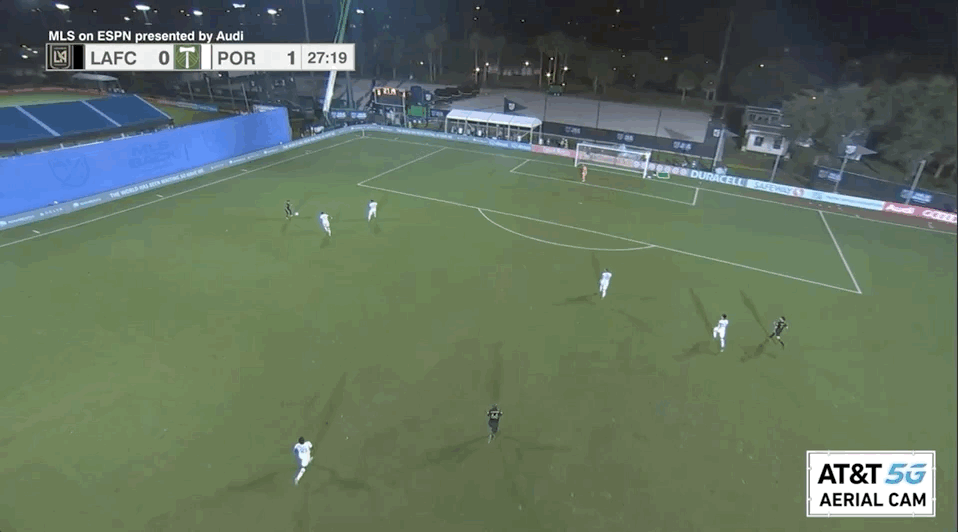
Here, the defense does a great job to cut this pass off as LAFC looks to make a direct pass towards the top of the box.
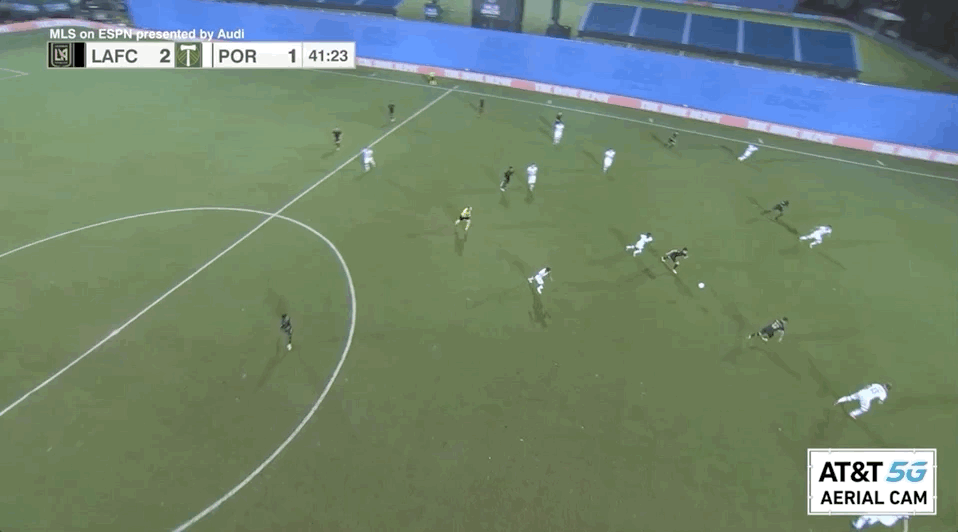
This third example is what happens when you have a defensive midfield of Diego Chará and Cristhian Paredes. Portland wanted to ensure that if LAFC tried to play centrally, they would be punished. And it worked.
There’s so much that I wanted to touch on when it comes to the defense side of the ball that I thought I should separate it into two different sections.
The defensive shape that Portland used was a very compact 4-4-2. How it defended was in a mid-block.
By playing this way, the Timbers invited LAFC to towards midfield before applying pressure. The goal of this is to create space in behind LAFC’s backline, and then take advantage of the aggression to create opportunities by running into this now-vacated area.
The Timbers were relatively successful early on but, from the 30th minute until halftime, players started to get tired, and they stopped playing into the space that they created after winning the ball. This allowed LAFC to implement a counter man-marking system, which continued to win the ball high up the field, effectively trapping Portland in its own half.
“I think what was difficult today was when we lost the ball so quickly,” Diego Chará said after the game. “When we recovered the ball, we tried to play forward, but we missed a lot of passes, and I think that made it more difficult for us to keep the ball.”
All of this is evident in the graphics below.
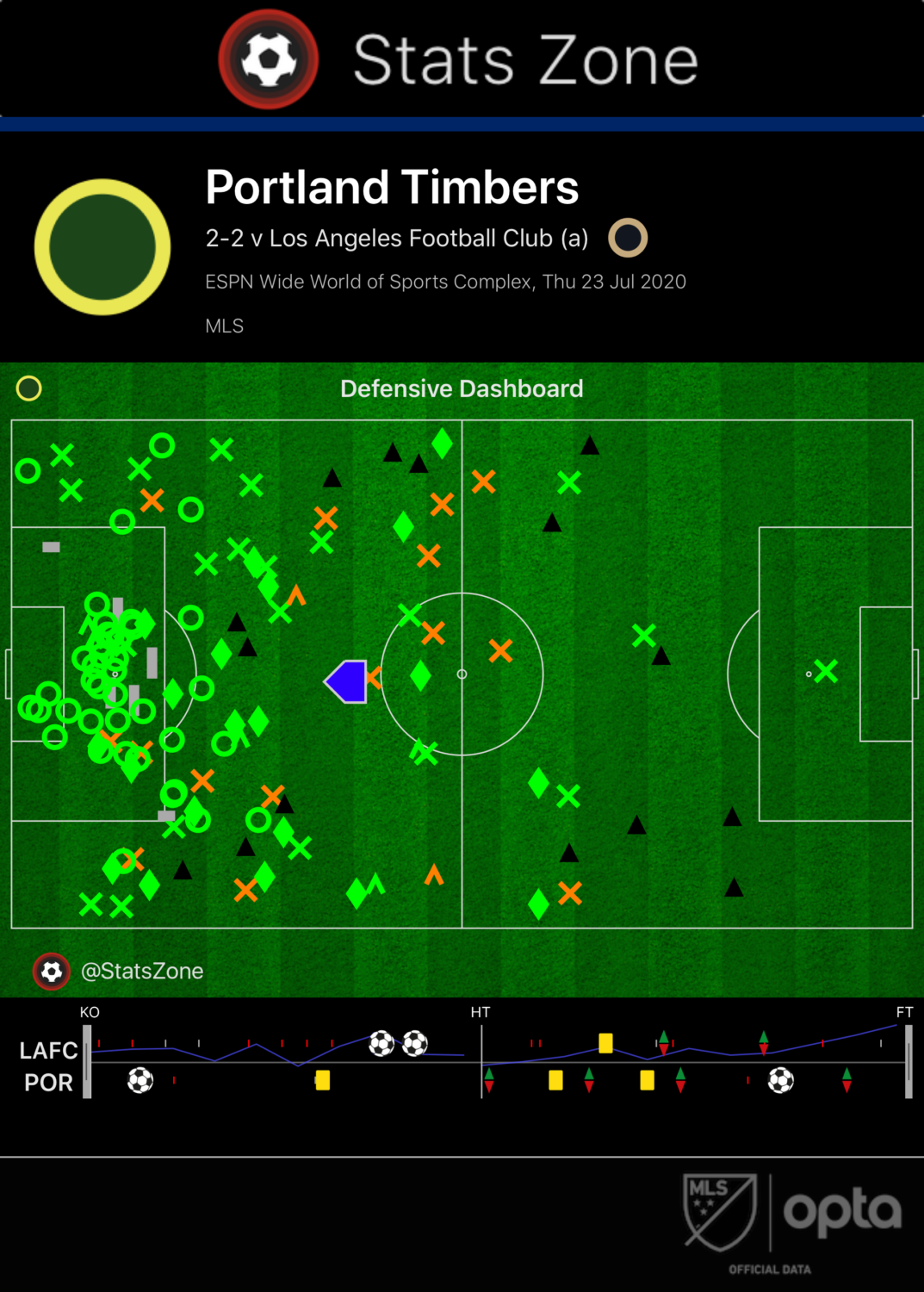
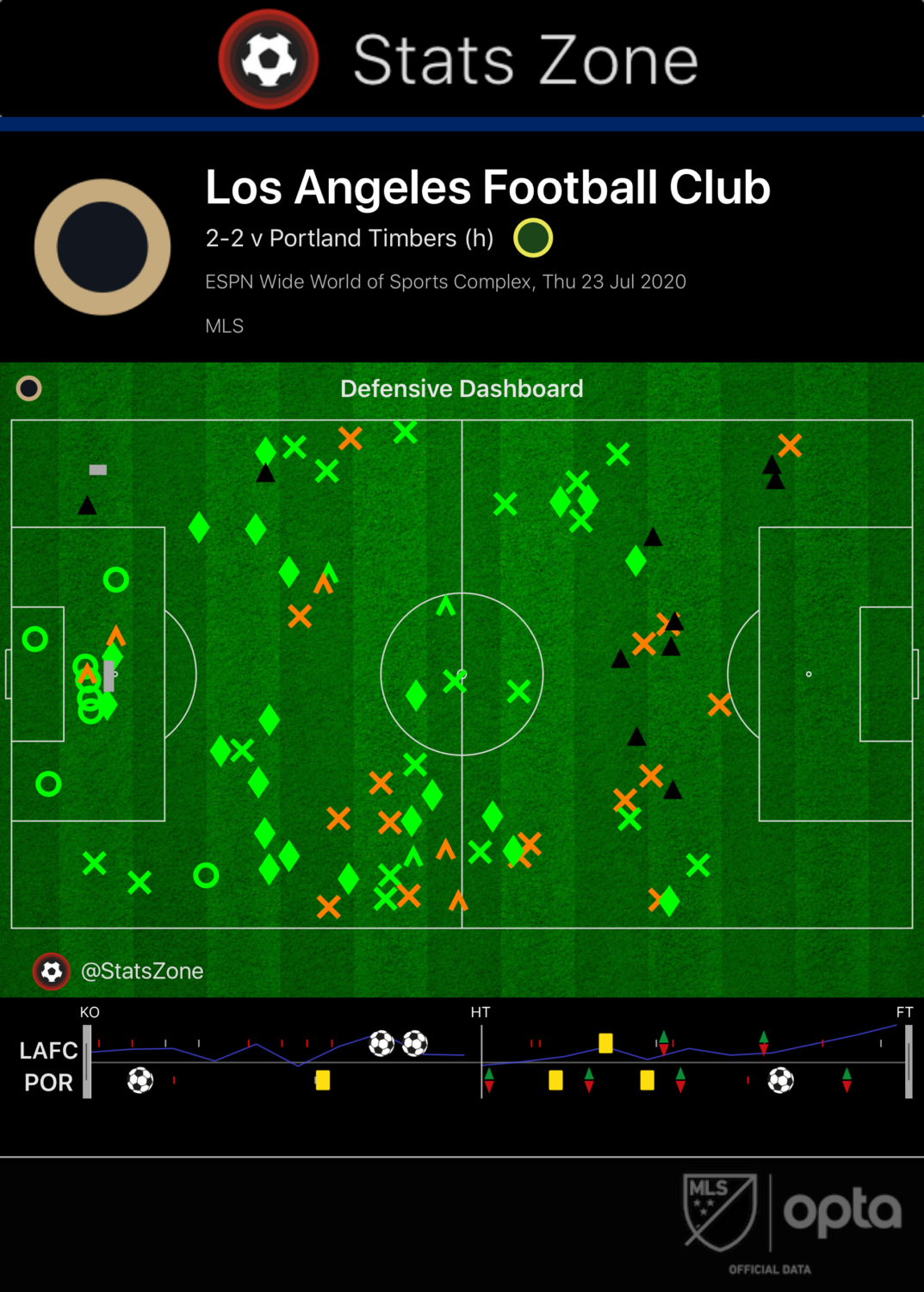
Look at where Portland defends versus where LAFC defends. Portland is playing a dangerous game of bend-but-don’t-break soccer, mostly in its own half, while LAFC is constantly trying to play on the front foot.
I can throw so many more graphics and stats such as the ones above in the article, but I don’t need to. The Timbers put on a defensive masterclass on Thursday night. Sure, it wasn’t perfect, but it’s the type of shape that every team that wants to make a deep run into a tournament needs. It’s important to remember that LAFC can exploit any defensive system and, if the Timbers could look like this defensively every game, they could go quite far in Orlando.
“The first thirty minutes we had the better of the play. We were very tight, and we didn’t allow them to be able to create much,” Savarese said when asked about LAFC’s dominant stretch. “In the last 15 minutes in the first half, they started to find the balls in between the lines; they started making better movements in those areas that we wanted to protect, and we were tired so we couldn’t close those spaces as well as we did the first thirty minutes.
“We also gave up the ball in those moments, different than the first thirty minutes when we had a lot of the ball and were smart in the way me moved it. I think that the two goals were two moments that are a little bit separated from them finding space. Yes, they had a little bit more of the ball in those minutes, they tried to create, but we defended very very well even though we had some players being tired.”
When a team presses as hard as LAFC does, the opponent usually has two options: A) Try to play through the pressure in hopes to find space to attack into; or B) Stop thinking for a few seconds and clear the ball, praying to find a teammate somewhere in the attack.
In the past, the Timbers would have taken option B, trying to recycle the ball wide and play it long, which often resulted in a quick loss of possession. But these are not the Timbers of old. Against LAFC, Portland invited the pressure and attempted to move up the field through multiple series of intricate passing and combination play. It did not always work, but when it did it was pretty.
Part of playing through a press is knowing when to commit numbers forward after winning the ball versus when to sit back. Whatever the decision is, every player needs to be on the same page to ensure that there are no gaps. Playing into the created space catches a team when they are most vulnerable at the back, but if you lose the ball, there is now plenty of vacated space for the opposing team to exploit.
Above is an example of what happens when a team gambles wrong. Remember the compact 4-4-2 block I pointed out above? This is what it looks like when caught in transition.
“It was a challenge trying to balance [attacking versus defending], understanding that we didn’t want to expose ourselves defensively, but also not wanting to sacrifice the potential for a counter-attack and getting in behind the space that they were leaving,” Jeremy Ebobisse said. “A fine line for attacking players, myself and the wingers, to balance, but ultimately I think that we had some good opportunities on the break.
“That shows a job well done to manage difficulties when they had the ball and were penetrating us and those times we were able to break out, complete a few passes, and unbalance them.”
As Ebobisse eluded to, this is a formula that teams have to get right every game. There were moments in which the Timbers were caught out, like shown above, but overall they put in a solid defensive shift and allowed their attacking talents to find a pair of goals on the other end of the field.
Now it’s onto the round of 16, where FC Cincinnati awaits. One of the surprise teams of the tournament so far, the onus will most likely be put on the Timbers to break down a compact Cincinnati side. If Portland can put together everything that they’ve shown from the group stage of this tournament, advancing to the final eight is a real possibility.
It’s time for revenge.
Video courtesy of ESPN aerial cam. Graphics courtesy of Opta and StatsZone.
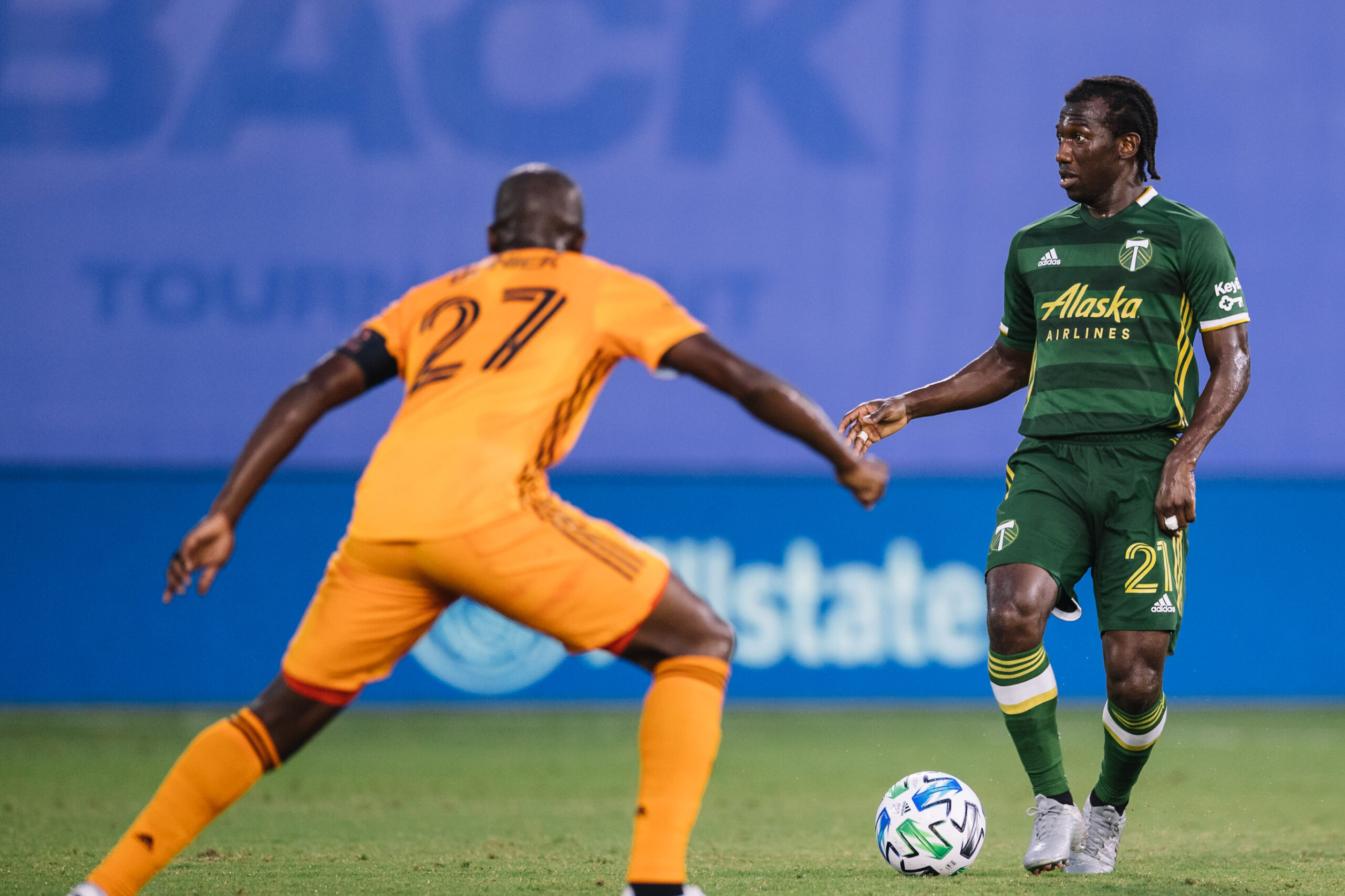
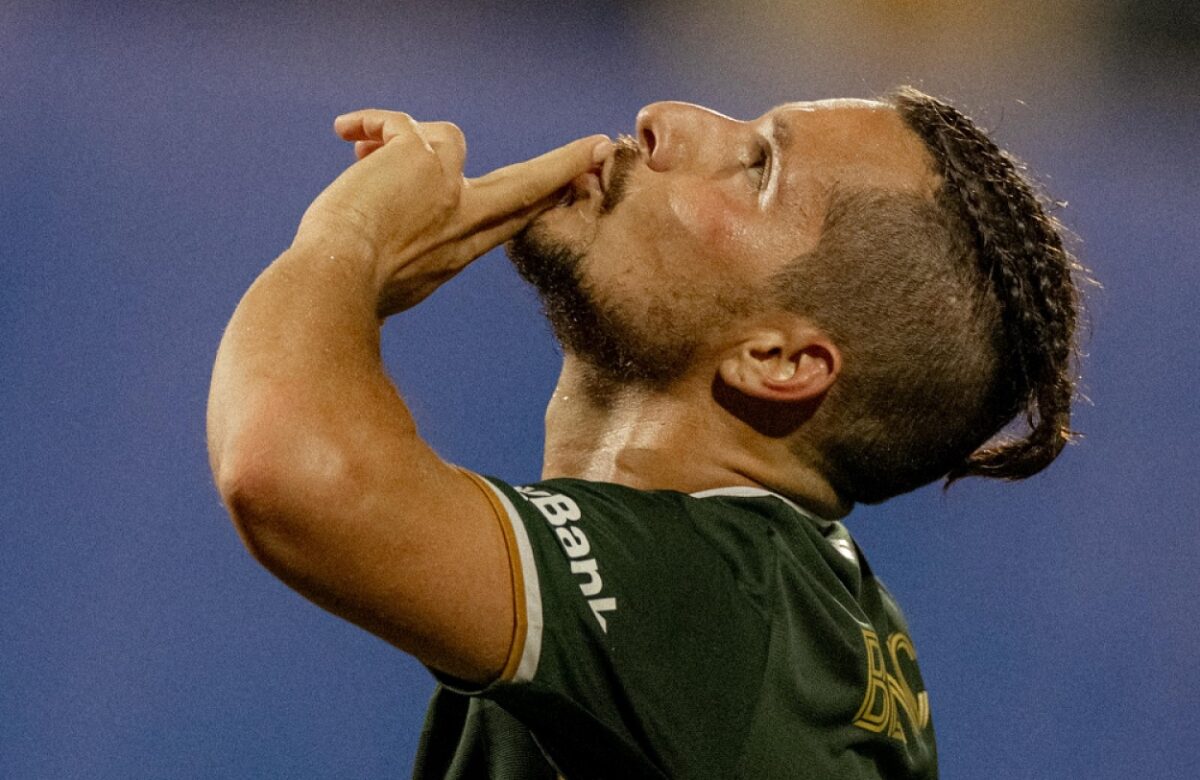
After four months without a match, the Portland Timbers returned to play last night in the MLS is Back Tournament. Before the opening whistle, cameras at the ESPN Wide World of Sports caught Diego Valeri in a smiling conversation with an LA Galaxy player.
Moments later, the Maestro and every other player on the pitch were kneeling in silence.
And moments after that, the whistle blew and the Timbers were once again playing soccer.
Despite a 75th minute red card to center back Dario Župarić, the Timbers were able to snatch all three points in Monday night’s up and down affair against the Galaxy––taking down the Californian side 2-1 in their first action since the suspension of the MLS season back in March. The match itself played out in four phases:
It was that third phase that gave us the most exciting moments to hold on to when the Timbers opened the scoring in the 59th minute and quickly followed that up with a second goal in the 66th.
The first goal was a pure distillation of this Timbers side. Yimmi Chará started the moment with an impressive snap header on goal off a cross that looked over-hit, forcing David Bingham to palm the ball away with a quick reaction save. Then Diego Valeri and Sebastián Blanco combined brilliantly as the Maestro received the ball at the top of the Galaxy box and patiently picked out a long, curving run from Blanco in behind the Galaxy back line. And, finally, Blanco was able to turn on the ball and pick out Jeremy Ebobisse in front of goal, threading a pass through a handful of defenders for Ebobisse to knock home despite a defender firmly attached to his back.
The second goal was simply down to the sheer cussedness of Blanco. After a shot from Ebobisse was deflected off his foot and sent looping away from goal, it seemed certain that the Timbers attack was broken and the Galaxy would have a chance to clear. As the ball fell back to earth out on the wing, however, Blanco refused to let it die. Rushing forward, he got a head to the ball, catching a defender unaware and skillfully touching it toward goal where another Galaxy defender was waiting to make the tackle. Instead, Blanco was able to somehow push the ball through that second defender and into space in front of the Galaxy goal where he wrapped up the move by hamming home a shot from close range that left Bingham waving hopelessly at the ball as it flew by.
While Blanco and the Timbers attack grabbed the win for the side, the defense nearly gave the game away on two occasions before clamping down and securing the three points for the side.
In the 11th minute, on one of the first attacking moves from the Galaxy as they tried to escape a protracted period of possession from the Timbers, a deflected ball fell to Cristian Pavón twenty yards from goal. Approaching the top of the box, the Galaxy No. 10 let loose a shot that flew directly into the torso of Župarić, clattering off his arms and immediately drawing a whistle and a yellow card from referee Ramy Touchan.
Chicharito Hernández stepped up to the spot and, with Timbers hearts sinking, struck his attempt on goal. Steve Clark, however, had other ideas and, reading the Mexican international legend’s run up, dove the correct direction and stopped his shot. Then, scrambling, Clark did the splits to stop the follow-up from Sacha Kljestan before diving on the ball to end the Galaxy hopes of an easy opener.
Although he was bailed out by Clark, that yellow card would come back to haunt Župarić in the 75th minute when he took down Pavón just outside the Timbers box, prompting an easy second yellow from Touchan and leaving the Timbers down a man for the rest of the game.
While the Galaxy would eventually find the back of the net in the 88th minute when Chicharito momentarily showed off some of the predatory instincts that made him such an effective player throughout his career, they were stymied time after time by the Timbers backline stepping up for an offside trap or swarming the ball to take advantage of a loose touch, or simply knocking away cross after cross that the Galaxy sent hopefully into the box.
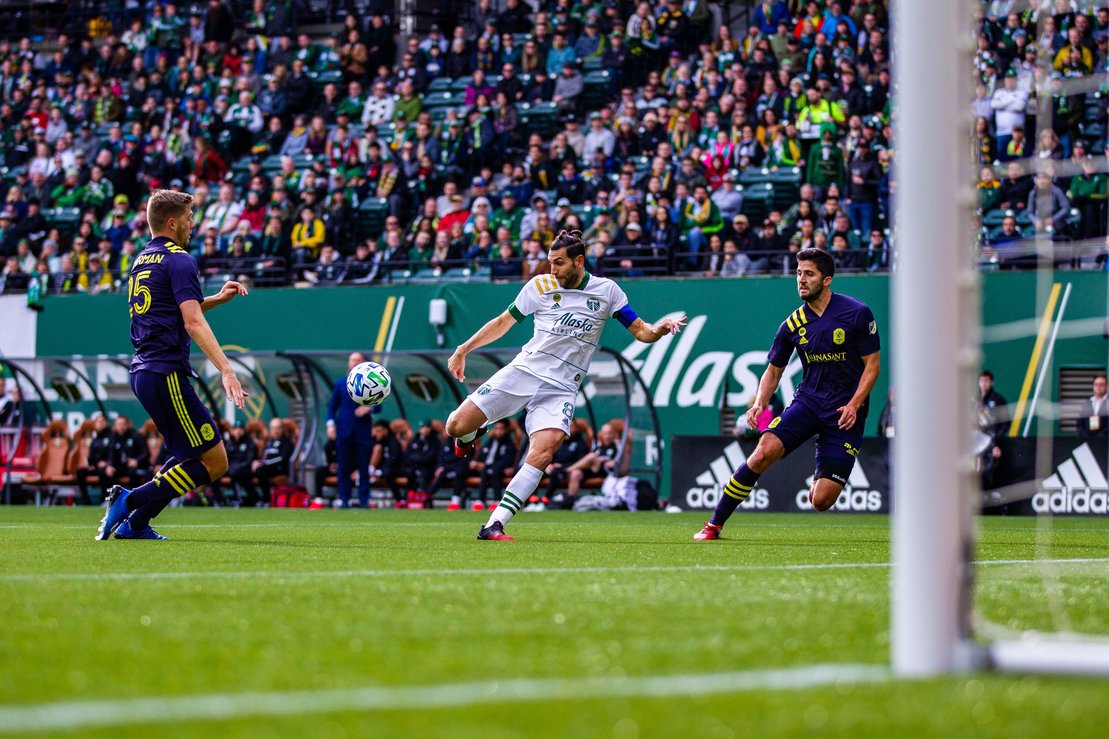
Players have been tested, teams are beginning to filter into Orlando, and we are just over a week away from kickoff of the MLS is Back Tournament.
Nearly four months have elapsed since LAFC and the Philadelphia Union played to a 3-3 draw back in early March. And before Inter Miami and Orlando City take to the field, Rose City Review talked to Joe Lowery—who currently co-hosts the MLS Assist Podcast—about the Timbers’ potent attack, defensive question marks, and the many ways in which they could create chaos in Orlando.
(The conversation below has been edited for clarity and length)
Kyle Pinnell: It’s been about a week since the draw. What were your initial thoughts on Group F, and more specifically, the Portland Timbers?
Joe Lowery: It’s going to be really interesting in terms of the on-field stuff, right? It’s going to be interesting to see how teams take things and how coaches want to approach the group stage which is actually worth points long term. There are a lot of questions as far as that goes, but looking specifically at Group F, there are a lot of unknowns in that group, I think.
You have LAFC, and we kind of know what we are going to get from them, although it will be interesting with the addition of Andy Najar to see how that is going to change things if he gets minutes. With the Timbers, Houston, and the Galaxy, to be honest with you, those teams all have large question marks around them.
The Timbers, I don’t think they defended well. Their defensive block, which is really really important to how they want to play, wasn’t very solid. The Galaxy are still trying to figure out how to attack with Chicharito and Cristian Pavón, and then the Houston Dynamo are right in this revamp under Tab Ramos, and they’ve only had two games to sort that out—those games were without Alberth Elis. We don’t really know what the Dynamo look like, we know what the Timbers want to be, and we know what the Galaxy want to be, but they aren’t there yet either. There are a lot of unknowns, especially after LAFC, in that group.
Pinnell: Yeah. We know how the Timbers want to play, they want to press and play a beautiful style of soccer, but that has turned into counter-attacking, playing long balls over the top, and hoping for interesting results. Over the first few games of the season, what have you seen when you watched the Timbers?
Lowery: With the Timbers, it’s interesting to me because every coach says that they are going to play with the ball, every coach wants to have the ball for the most part. The Timbers, in a way, still have the pieces to do that. They have two of the highest skilled on-ball players in the league with [Diego] Valeri and Sebastián Blanco. You think about having those two guys as attacking midfielders in a possession scheme, that sounds pretty nice, I love that idea. You have Diego Chará who is nice on the ball as well and he can do things in possession as a number six.
They have options here in certain spots, but not all the way around, and I think that is the problem here. They have guys along the backline, specifically center backs, that I don’t think are great with the ball. I’ll have to watch them more, but they never stood out to me as being these offensive powerhouses, which makes it difficult to keep possession a lot of the time.
Whether it’s the center backs or it is the fullbacks or the team not having that cohesion in possession, so often I think they revert to what seems to be their DNA for one reason or another. That’s sit in a defensive pocket, press occasionally, and then win the ball and have Diego Valeri and Sebastian Blanco be the playmakers on the fast break. They can do more things than that. They can hold the ball and play through those guys in possession, but for some reason, they seem to continue to go back to that counter-attacking style, which is fine, it’s a totally viable approach, it just seems like they are lacking a little bit in terms of their tactical identity with the ball on the field.
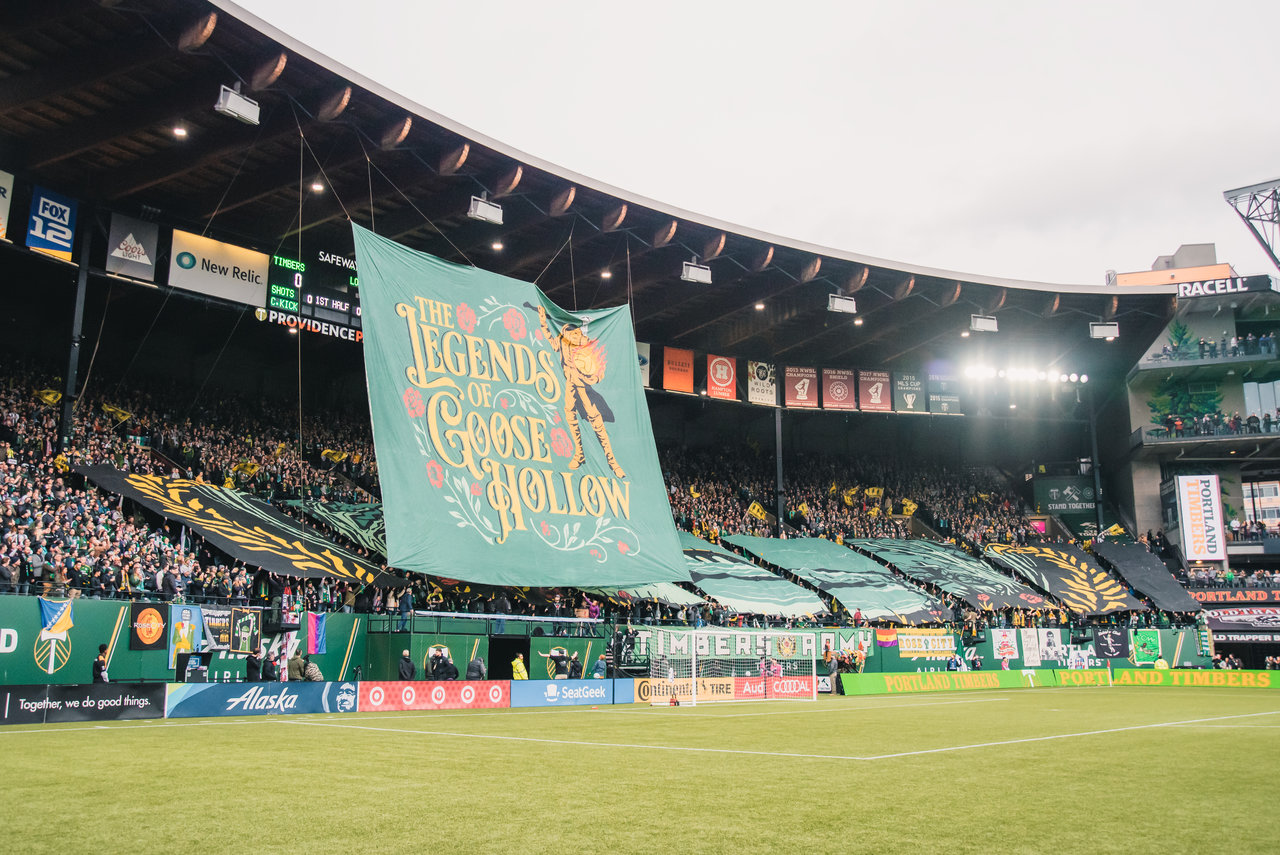
Pinnell: Going back to what you’ve seen out of the Timbers, when you watch them in Orlando, what will you have to see change to make it seem like the team is going in the right direction or that you’re seeing positive change?
Lowery: I think with the Timbers, seeing them shore up their defensive block would be big. Because I don’t think they’re ever going to be the team that has the ball for 60 percent of the game, or at least not in most games. When you’re not that team, your defensive block is really important because you’re playing against the ball for a lot of the game.
Going back to LAFC as an example, imagining a matchup between those two teams on the field, right now I don’t have a lot of confidence in the Timbers’ defensive shape to be able to contain a possessive team like that. But if they come in, they understand their roles in a defensive block—if they’re in a 4-4-2 or 4-5-1, whatever it is—they understand their assignments, where they need to be, and how they’re going to shift to deny penetration and force the ball wide if that’s what [head coach] Gio [Savarese] wants to do. They’re going to need to know when to trap, when not to trap, and when to step versus when not to step. If they can work that out, and if they have worked that out in this last three-month break, that’s going to be a great asset for them. That takes the Timbers from being a bad team in my mind to being a dangerous team that you don’t really want to play.
Pinnell: Looking at Diego Chará, he sometimes drops into the backline to help the team build possession and carry the ball into the midfield. How do you see the Timbers getting the ball from the backline, which you’ve said yourself doesn’t have any players excel at playing out of the back, into the midfield where they can be more dangerous?
Lowery: Having [Diego] Chará drop a little bit is a look that I actually really like with the Timbers. Maybe it’s Valeri, maybe it’s Blanco, maybe it’s Paredes dropping in a little bit; it allows the midfielders to get touches on the ball and distribute, which I appreciate. You just find the balance with that because you also want Valeri and Blanco higher up the field as well. Maybe you bring one of them down deeper into midfielder and you have the other one staying a little higher, that’s fine. I like that rotation with [Diego] Chará dropping from his six spot in between the center backs, moving the center backs out wide, pushing the full backs a little higher, and then you have Valeri and Blanco in those interior channels or in the middle of the field.
Then you have Yimmi Chará or whoever else is playing up front, that allows you to get those guys touches off of passes from Valeri and Blanco. Moving [Diego] Chará deeper I actually think is a pretty sustainable and successful look for the Timbers.
Pinnell: Now, when you observe the roster as a whole, who are some important players that you will be keeping an eye on?
Lowery: I want to see if/when/where Jeremy Ebobisse plays. I don’t think anybody really knows where he is going to play. I think that he should play as a [No.] 9 or as part of a front two, but that can be difficult with needing to give Valeri some touches up top, or how do you defend as part of a front line in a defensive block. I want to see where Ebobisse factors in, because I think he has something to bring to the table that he hasn’t had the chance to show for the Timbers.
Outside of that, I want to see more from Paredes as well in midfield. He’s a guy who is the unsung hero of that midfield in a lot of ways. [Diego] Chará gets a lot of headlines, and then Valeri and Blanco get the rest, so it’s a little challenging to know exactly what impact he’s going to have in this tournament. I like him as a player; I want to see more of him and focus on him more in that Timbers midfield. So Ebobisse and Paredes are the two guys for me that I am curious to watch with a more analytical eye on this tournament.
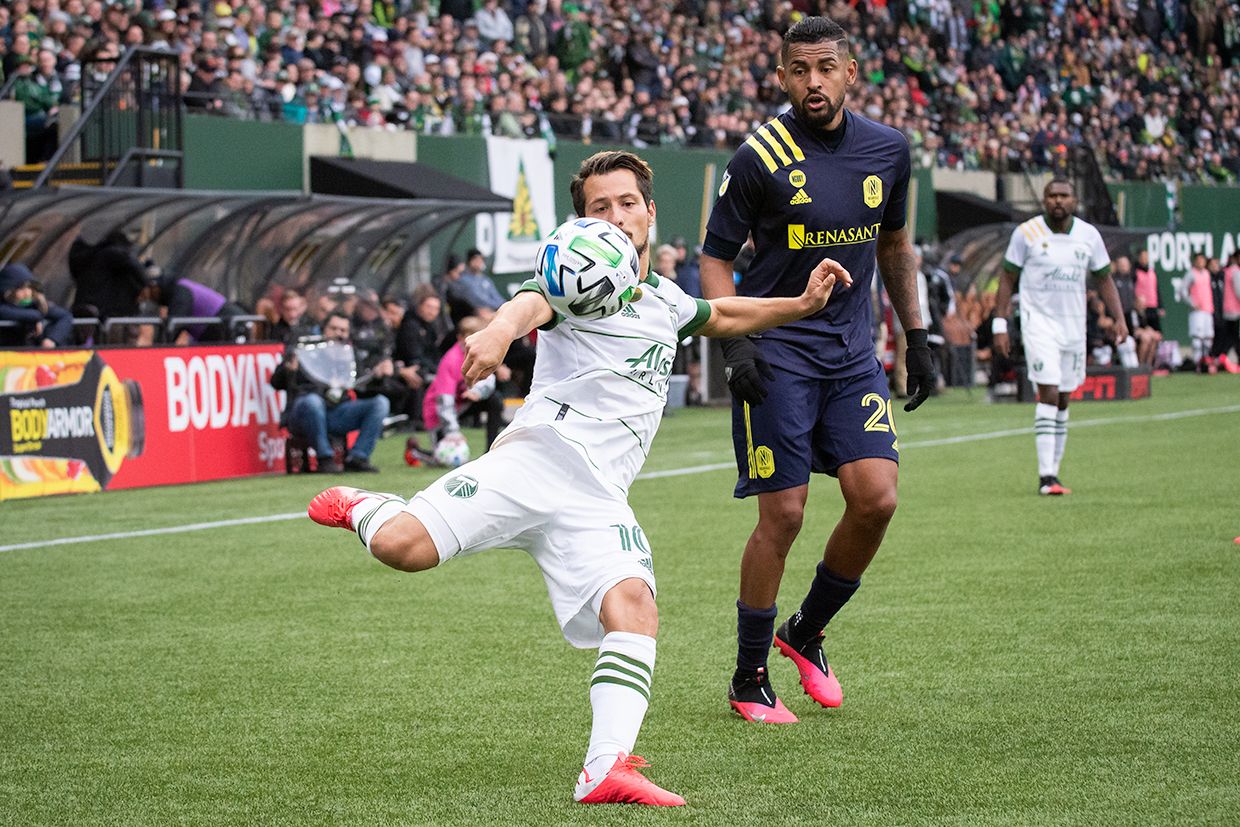
Pinnell: We started our conversation by talking about Group F as a whole, and honestly, the two teams that advance from the group could be a toss-up. With every team having questions, it might come down to which team has the most tactically adept coach who can tinker enough to find that formula to get them through the group. What coach do you think gives his team a distinct advantage for that second spot?
Lowery: So far, Barros Schelotto has been very predictable with how he plays, getting crosses into the box early and often throughout games. I think that unless we have a come-to-Jesus moment there with Barros Schelotto, then we’re going to see the same thing which is fairly predictable in a lot of ways.
Tab Ramos, I just straight up don’t know. Houston’s roster I don’t think is as talented as the Galaxy’s, maybe more similar to the Timbers in that regard. And with Gio Savarese, they’ve got the MLS Cup appearance, sure, but I’m not necessarily convinced that the Timbers are the finished product right now either. I’m not sure whether one coach has the tactical edge over another, to be quite honest with you.
Outside of Bob Bradley—I think he’s the number one guy in this group if we’re looking at just coaches. In terms of talent, though, if the Galaxy don’t advance from this group, and they actually try because we don’t know how the on-field quality is going to be, with Cristian Pavon especially—who I think is right up there with Carlos Vela in terms of best player in MLS, I think we’ll see that if we get a season this year—if they don’t make it out of this group, that’s going to be a little more unfortunate for them than it is for the Timbers or Dynamo. But as far as coaches go, I think it’s pretty even.
Pinnell: I agree, Bob Bradley definitely seems to be a level above most other coaches in this league. In an article that I recently published, I mentioned how the Timbers might be able to exploit space between lines. In a tournament like this, how do you think that the team could create that space?
Lowery: I think first of all that LAFC and Houston will open themselves up, which is good for a team like Portland because they want to attack into that open space. Looking at the Galaxy, that’s a different question. A lot of times they are going to get forward just because of the roster they have. They have the attacking talent, so it would be ridiculous for them not to get forward.
Still though, the Galaxy don’t play the same way that LAFC do or that Tab Ramos wants to do with Houston. So against a team like the Galaxy, they’re going to have to have possession a little bit more. They’re going to have to rely on their playmakers to get balls in from the backline or from Diego Chará, and then allow Diego Valeri’s off-ball movement, which is very very good, and have that captain them to better possession results. They have the tools in possession, and in the attack especially.
Getting the ball to Diego Valeri is one thing, but once they get the ball there, if they can get the ball there, then you are really cooking with something. If Valeri and Blanco can get on the ball in dangerous spots and get the ball to those spots in the first place, then the Timbers can pose a real threat with the ball against a team like LA. Creating and exploiting space in possession is going to be the thing for them, and I really do think that it comes down to how well their playmakers can get into spots and then distribute from there.
The rest of our conversation with Lowery is available in audio format for our $10 Patrons. You can find it under the “Patreon” tab on our website.